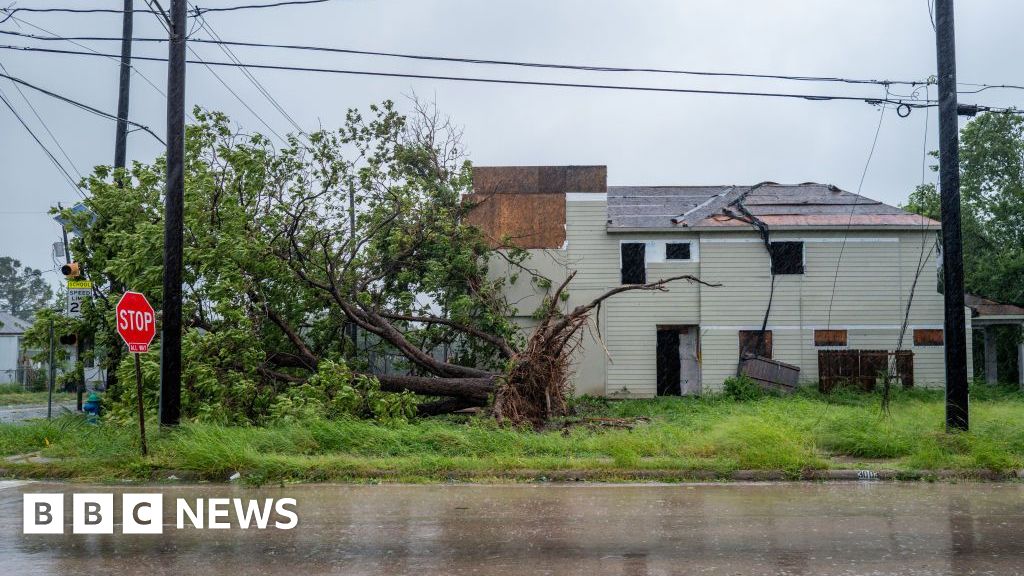At least four people have died as Hurricane Beryl slammed into south-east Texas, knocking out power for more than 2.6 million people while bringing heavy rain and fierce wind gusts.
When Beryl first hit Texas on Monday morning, it landed as a category one hurricane, but it has since been downgraded to a tropical storm.
Officials warned of destructive winds, up to 15in (38cm) of rain and “life-threatening” storm surges.
More than 1,100 flights at Houston’s main airport were cancelled on Monday, according to flightaware.com.
Some 2.6 million customers in Texas were without power as of Monday afternoon, said poweroutage.us.
The state governor’s office has urged residents not to underestimate the storm, which caused at least 10 deaths in the Caribbean days before.
The Houston Chronicle reported that four people had died in Texas, but an affiliate of CBS News, the BBC’s US partner, said seven had died in Harris and Montgomery counties.
A 53-year-old man died after winds downed power lines and knocked a tree on to his home in Harris County, causing his roof to collapse.
In the same county, which includes parts of Houston, 73-year-old grandmother Maria Loredo was reported dead after a tree crashed through the roof of her home, according to CBS affiliate KHOU.
Loredo’s family told the news station she was home with her son, his wife, and her two grandchildren, ages two and seven, when the tree fell. No other family members were injured.
Also in Harris County, a Houston Police Department employee, Russell Richardson, 54, drowned after attempting to drive through high water on his way to work, reports KHOU.
Another person died in a house fire that is believed to have been sparked by lightning, Houston’s mayor said.
Three people were also killed in Montgomery County. Officials say one man was killed when a tree fell on him while he was driving a tractor, and two homeless people died when a tree fell on their tent, reports KHOU.
Houston is a low-lying coastal city, making it prone to flooding.
Sustained wind speeds in the Houston area reached 75mph (120km/h) with wind gusts reaching 87mph.
Beryl was expected to continue to lose strength as it gradually tracks north-northeast, but flash flooding and heavy rain remained a risk.
Tornado warnings were issued for dozens of other Texas counties in its path, including a few counties in Louisiana.
Earlier, the city of Galveston, south-east of Houston, issued a voluntary evacuation order for some areas as storm surges in the area were predicted to reach 4-6ft above ground.
The ports of Corpus Christi, Houston, Galveston, Freeport and Texas City were all closed, meaning there could be a temporary halt to trade.
All vessel movement and cargo operations have been restricted.
More than 2,500 emergency responders have been made ready to deal with Beryl’s aftermath, including members of the Texas National Guard.
Beryl was expected to move east across America’s central states, including Mississippi, later in the week.
In the process, it will likely skip over central and west Texas, areas that are currently experiencing moderate to severe levels of drought.
At one stage, Beryl became the earliest category five hurricane ever recorded.
In the Caribbean it hit St Vincent and the Grenadines, Mayreau and Union, and Grenada especially hard.
The storm was also one of the most powerful to ever hit Jamaica.
Beryl brought heavy rain to the tourist hotspots of Cancún and Tulum in southern Mexico.
While it is difficult to attribute specific storms to climate change as the causes are complex, exceptionally high sea surface temperatures are seen as a key reason why Hurricane Beryl has been so powerful.
It is the first hurricane of the 2024 Atlantic season but the US National Oceanic and Atmospheric Administration has warned that the North Atlantic could get as many as seven major hurricanes this year – up from an average of three in a season.





